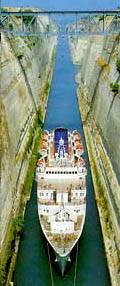|
Corinth City

Corinth Isthmos Canal |
Welcome to Korinthos!
In the age of myth, Korinthos (or Corinth) was always being thrown into turmoil by tribes pouring into the Peloponnese from Isthmus. With the setting of Dorians (9th c BC), Corinth’s history began. It became a great naval power and perfected the trireme. The Corinthians were the first to have the idea of cutting through the Isthmus but were unable to accomplish it. Instead they invented and built a paved slip way called Diolkos in order to haul their boats over the Isthmus. They were foremost in the arts, especially in ceramics. The 5th century was their most glorious period. But when Athens became powerful Corinth fell into decline. In 146 BC the Romans destroyed it completely.
Later in 67 BC Nero started digging to create a big trench, but the work stopped due to his death. Finally in 1891-1893 the canal became a reality. The town rose again in the 11th century. In 1212 the Franks took over the place until 1395 when the Byzantines gained the advantage, only to sell the town to the Knights of Rhodes five years later. In 1458 it fell to the Turks. A strong earthquake razed the town in 1521. It became property of the knights of Malta 1612, passed to the Venetians in 1687 and was recaptured by the Turks in 1715. They were ousted in 1822.
Corinth is also known from the letters to the Corinthians of Apostle Paul and his preaching here.
The ruins of ancient Corinth are spread out at the foot of the huge rock of Acrocorinth. The monuments are mainly Roman and only a few are Greek. You can trace the Long Walls which began at the summit of Acrocorinth and descended all the way to Lechaion, the artificial harbor on the Corinthian Gulf. The Doric temple of Apollo (6th c BC with 1st c AD restorations) stands on a knoll to the north of the agora and it is the most important monument of that period. The museum is in the southwest sector of the site. It contains mosaic floors, Mycenaean and Corinthian pottery, terra cotta sphinxes, statues of two supernatural beings, relief plaques, the Roman head of the Goddess Tyche and small objects of various kinds.
The imposing mass of Acrocorinth rises out of the ground at the edge of the ancient city. At the top of the pinnacle, at an altitude of 575 m stood the acropolis of Corinth during ancient and medieval times. This is the largest and the oldest fortress in Peloponnese
|
|
|
|



